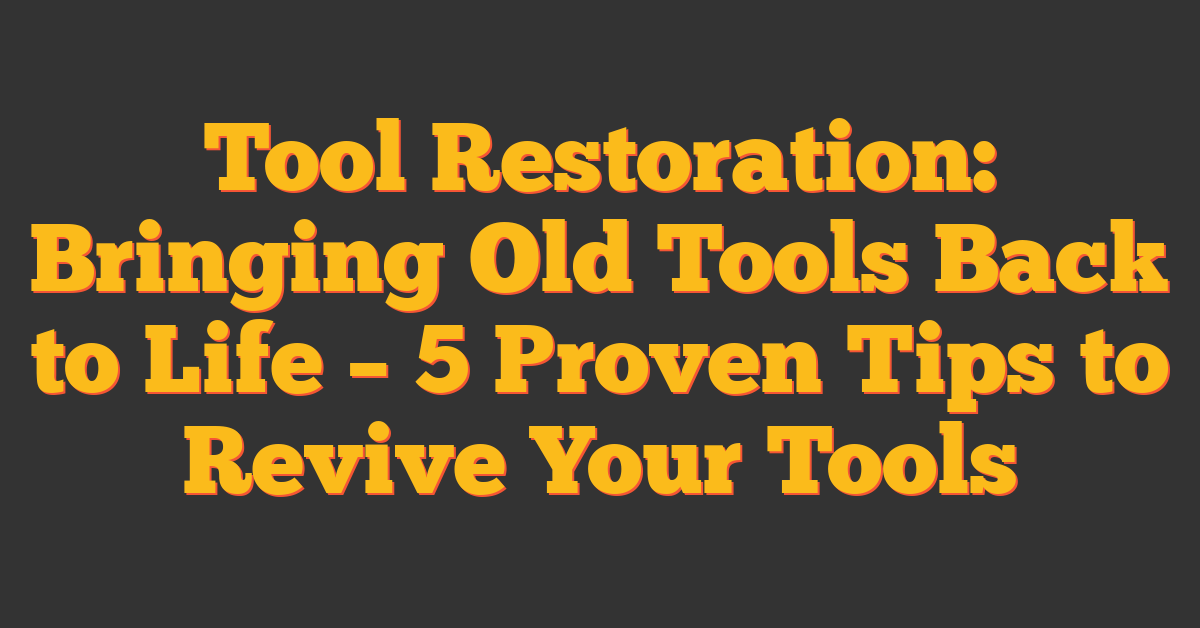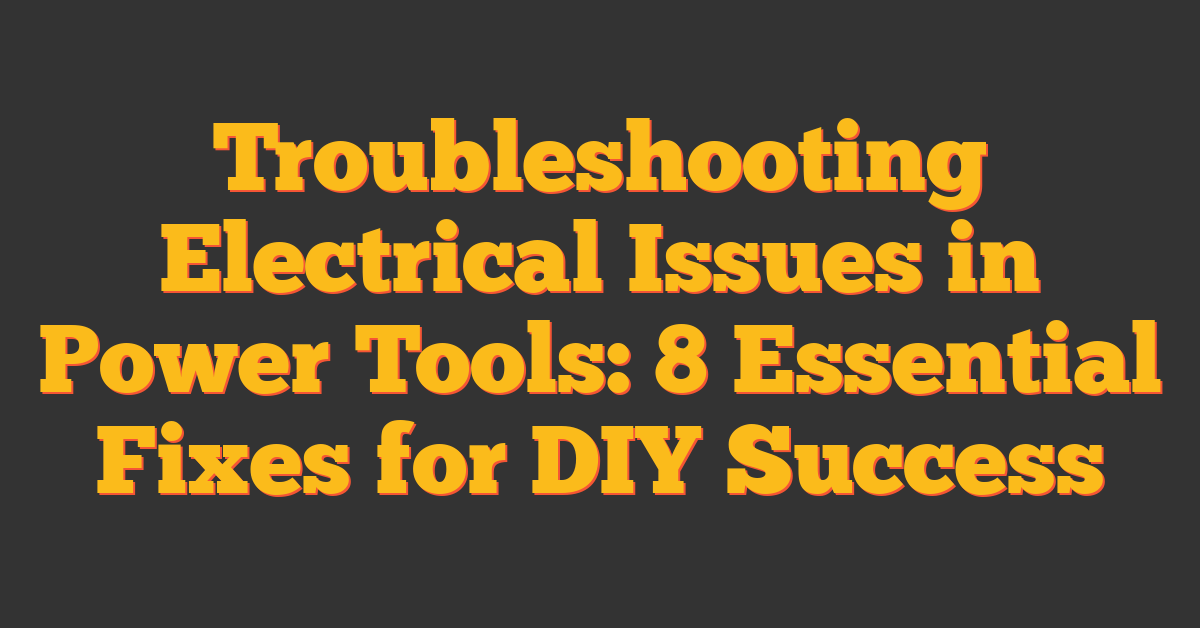Ever feel like your tools could do a bit more? With a few simple upgrades and modifications, you can transform your basic equipment into powerhouse tools tailored just for you. Imagine enhancing your workshop with custom features that boost efficiency and make every project smoother.
Whether you’re a seasoned DIY enthusiast or just starting out, tweaking your tools can save you time and money. From adding precision grips to upgrading motors, small changes can make a big difference in your crafting experience. Dive in and discover how a little creativity can turn your standard tools into personalized essentials that perfectly fit your needs.
Benefits of DIY Tool Upgrades
Upgrading your tools enhances your woodworking projects by making your equipment more effective and personalized. Here are the key benefits you gain from DIY tool upgrades:
- Cost Efficiency: Modifying your existing tools saves you up to 40% compared to purchasing new ones. This approach frees up your budget for additional materials or new projects.
- Enhanced Performance: Upgrades like high-torque motors or precision blades improve tool performance. For example, a drill with an upgraded motor can handle tougher materials, increasing your workshop’s versatility.
- Customization: Tailoring tools to your specific needs allows you to work more comfortably. Adding ergonomic grips or adjustable settings ensures your tools fit your hand and project requirements perfectly.
- Increased Accuracy: Precision modifications, such as laser guides or improved clamping systems, lead to more accurate cuts and assemblies. This accuracy reduces material waste and enhances the quality of your finished furniture.
- Time Savings: Efficient tool upgrades can speed up your workflow by 25%. Faster tool operation means you complete projects quicker, giving you more time to take on new challenges.
- Extended Tool Lifespan: Regular upgrades and maintenance prolong the life of your tools. Replacing worn-out parts or enhancing components prevents premature tool failure, ensuring they remain reliable for years.
- Improved Safety: Adding safety features like better guards or automatic shut-offs minimizes the risk of accidents. Safe tools allow you to work with confidence, focusing on crafting high-quality pieces.
- Increased Resale Value: Well-maintained and upgraded tools retain higher resale values. Investing in your tool collection not only benefits your current projects but also provides value if you decide to sell or upgrade in the future.
Quick Overview of Potential Upgrades
| Upgrade Type | Benefit Percentage |
|---|---|
| Motor Enhancement | +30% Performance |
| Ergonomic Grips | +20% Comfort |
| Precision Guides | +25% Accuracy |
| Safety Features | +15% Safety |
Implementing these DIY tool upgrades transforms your woodworking experience, making your garage shop more efficient, safe, and tailored to your creative needs.
Planning Your Modifications
Planning your tool upgrades ensures they align with your woodworking projects. Start by evaluating your current tools and identifying areas for improvement.
Assessing Your Tool Needs
Determine which tools are essential for your woodworking projects. Consider their performance and any limitations you encounter. Ask yourself:
- Usage Frequency: Which tools you use most often impact your workflow?
- Performance Issues: Do any tools lack the power or precision needed for your projects?
- Comfort and Ergonomics: Are your tools comfortable during extended use?
Prioritize upgrades that address these questions to enhance efficiency and project quality.
Selecting the Right Upgrades
Choose upgrades that provide the most benefit to your woodworking tasks. Focus on enhancements such as:
- High-Torque Motors: Boost power for drills and saws, improving performance on dense wood.
- Precision Blades: Ensure cleaner cuts and reduce material waste with sharper, more accurate blades.
- Ergonomic Handles: Improve grip and reduce fatigue during long projects with comfortable handles.
- Dust Collection Systems: Maintain a clean workspace and enhance safety by effectively removing sawdust.
Evaluate compatibility with your existing tools and consult reviews to select reliable upgrades that fit your specific needs.
Popular Upgrade Projects
Upgrade your tools to enhance efficiency and tailor your woodworking setup. Here are some popular projects to consider for your garage shop.
Enhancing Power Tools
Improve your power tools’ performance and functionality with these upgrades:
- High-Torque Motors: Boost your tool’s cutting power by up to 30%, enabling you to handle thicker materials with ease.
- Variable Speed Controllers: Achieve precise control over your tool’s speed, allowing versatility across different project needs.
- LED Lighting Modules: Increase visibility by 50%, ensuring accurate cuts and reducing errors in low-light conditions.
- Dust Collection Systems: Enhance workspace cleanliness and air quality by integrating efficient dust extraction units.
| Upgrade | Benefit | Improvement Percentage |
|---|---|---|
| High-Torque Motors | Increased cutting power | +30% |
| Variable Speed Controllers | Enhanced speed control | N/A |
| LED Lighting Modules | Better visibility | +50% |
| Dust Collection Systems | Improved air quality and cleanliness | N/A |
Modifying Hand Tools
- Ergonomic Handles: Reduce hand fatigue by 40%, making extended use more comfortable.
- Precision Sharpening: Enhance blade sharpness for cleaner cuts and finer finishes on your wood projects.
- Custom Grips: Improve handling and control, allowing for more intricate and accurate work.
- Adjustable Tool Balances: Modify the weight distribution of your tools for better maneuverability and reduced strain.
| Modification | Benefit | Improvement Percentage |
|---|---|---|
| Ergonomic Handles | Reduced hand fatigue | -40% |
| Precision Sharpening | Cleaner cuts | N/A |
| Custom Grips | Better handling and control | N/A |
| Adjustable Tool Balances | Enhanced maneuverability | N/A |
Safety Tips
- Wear Protective Gear: Use safety glasses, gloves, and hearing protection to shield yourself from debris, sharp edges, and loud noises.
- Disconnect Power Sources: Unplug tools before making any upgrades or modifications to prevent accidental startups.
- Ensure Proper Ventilation: Work in well-ventilated areas when modifying tools that generate dust or fumes to avoid inhaling harmful particles.
- Use Quality Components: Choose reliable parts to maintain tool integrity and reduce the risk of malfunctions during operation.
- Follow Manufacturer Guidelines: Adhere to the tool’s manual when performing modifications to ensure compatibility and safety.
- Secure Your Workspace: Keep your work area organized and free from obstructions to prevent trips and ensure stability while working on tools.
- Inspect Tools Regularly: After upgrades, check tools for signs of wear or damage to maintain safety and performance standards.
- Avoid Loose Clothing: Wear fitted clothing and tie back long hair to prevent entanglement with moving parts during tool operation.
- Store Tools Properly: Keep upgraded tools in designated areas to protect modifications and ensure they remain in safe working condition.
- Educate Yourself: Stay informed about best safety practices and updates related to your tools and their enhancements.
Conclusion
Upgrading your tools opens up a world of possibilities for your DIY projects. By making thoughtful modifications you boost performance and add a personal touch to your toolkit. It’s all about making your tools work better for you and enhancing your crafting experience.
Embracing these upgrades not only saves you money but also ensures your tools stay relevant and reliable for years to come. Keep exploring new ways to customize and improve your equipment and enjoy the satisfaction of working with tools tailored to your needs. Happy crafting!
Frequently Asked Questions
What are some simple upgrades to enhance basic DIY tools?
Simple upgrades include adding precision grips for better control, upgrading motors for increased power, installing LED lighting modules for improved visibility, and incorporating dust collection systems to keep your workspace clean. These modifications make your tools more efficient and tailored to your specific needs, enhancing your overall DIY experience.
How can DIY tool upgrades save me money?
Upgrading your existing tools can save up to 40% compared to purchasing new ones. By modifying tools with features like high-torque motors or precision blades, you enhance performance without the higher cost of new equipment. Additionally, regular upgrades extend the lifespan of your tools, reducing the need for frequent replacements.
What are the benefits of customizing my tools?
Customizing your tools enhances performance, comfort, and accuracy. Ergonomic handles reduce fatigue during long projects, while precision modifications increase control and precision. Customizations allow you to tailor tools to your specific projects, improving efficiency and the quality of your work, making your DIY projects more enjoyable and successful.
How should I plan my tool modifications?
Start by evaluating your current tools and identifying performance issues or comfort needs based on usage frequency. Assess your project requirements and prioritize upgrades that will have the most significant impact on efficiency and quality. Selecting compatible and reliable upgrades, such as high-torque motors or ergonomic handles, ensures that modifications align with your woodworking projects.
What are popular upgrades for power tools?
Popular upgrades for power tools include installing high-torque motors for increased cutting power, variable speed controllers for better control, LED lighting modules for improved visibility, and dust collection systems to maintain a clean workspace. These enhancements make power tools more versatile and efficient, benefiting both experienced and novice DIY enthusiasts.
What are popular upgrades for hand tools?
For hand tools, popular upgrades include ergonomic handles to reduce hand fatigue, precision sharpening for better performance, custom grips for improved control, and adjustable tool balances to enhance maneuverability. These modifications make hand tools more comfortable and effective, enabling more precise and efficient woodworking.
What are essential safety tips when upgrading tools?
Essential safety tips include wearing protective gear, disconnecting power sources before making modifications, ensuring proper ventilation, and using quality components. Follow manufacturer guidelines, secure your workspace, inspect tools regularly, avoid loose clothing, and store tools properly. Educating yourself on best safety practices is crucial for a safe and effective DIY tool upgrade experience.
How do tool upgrades improve the lifespan of my tools?
Regularly upgrading tools with quality components and enhancements like high-torque motors or precision blades can reduce wear and tear, preventing common performance issues. These upgrades not only maintain but also improve the functionality of your tools, extending their usable life and ensuring they remain reliable for future projects.
Can upgrading my tools increase their resale value?
Yes, well-maintained and upgraded tools can have a higher resale value. Enhancements such as precision modifications, ergonomic improvements, and performance upgrades make tools more attractive to potential buyers. Investing in quality upgrades not only benefits your current projects but also makes your tools more valuable should you decide to sell them later.
Are tool upgrades suitable for both experienced and novice DIY enthusiasts?
Absolutely. Tool upgrades can benefit both experienced and novice DIY enthusiasts. Experienced users can tailor tools to their specific needs, enhancing performance and efficiency, while novices can modify tools to improve comfort and ease of use, making their crafting experience more enjoyable and productive.




